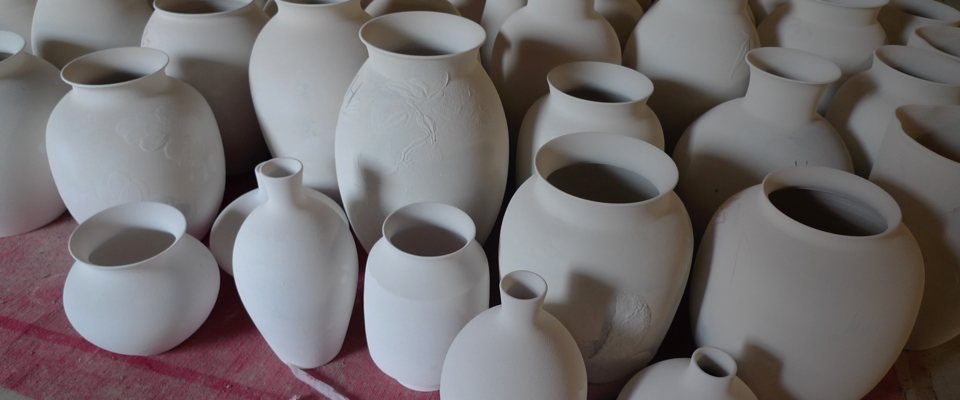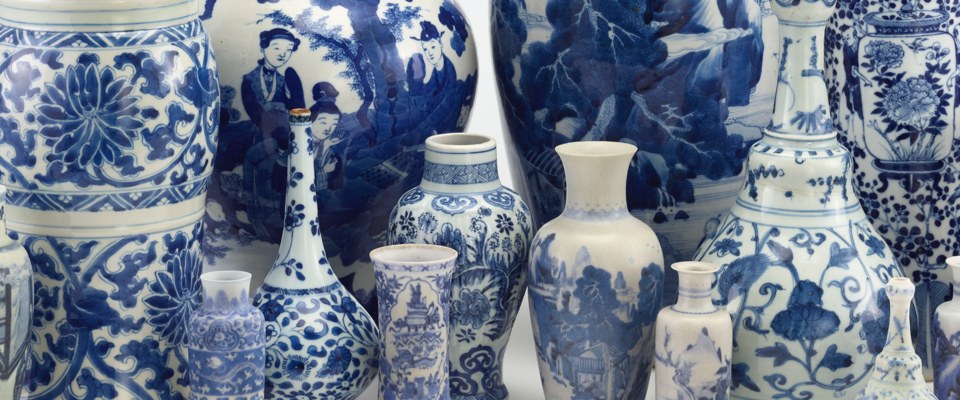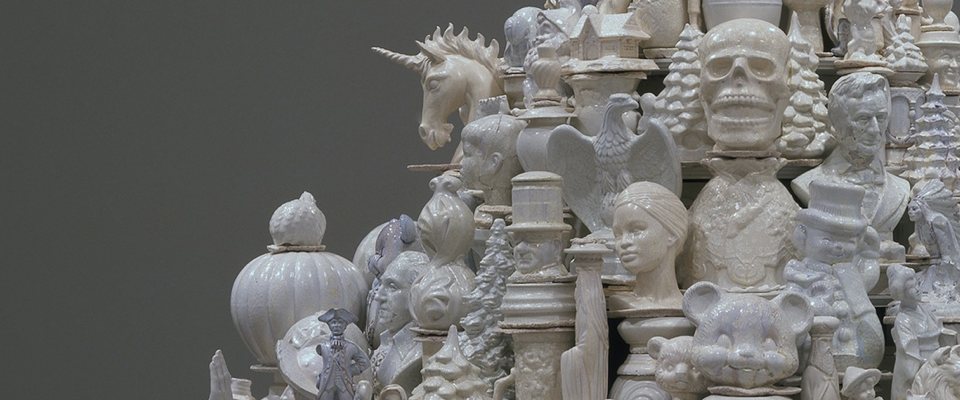July 9, 2016–June 4, 2017
-
Dates
-
Location
Arthur M. Sackler Gallery
-
Collection Area
Across Collections
A mania for Chinese blue-and-white porcelain swept through London in the 1870s as a new generation of artists and collectors “rediscovered” imported wares from Asia. Foremost among them was American expatriate artist James McNeill Whistler. For him, porcelain was a source of serious aesthetic inspiration. For British shoppers, however, Chinese ceramics signified status and good taste. Cultural commentators of the time both embraced and poked fun at the porcelain craze. Illustrator George du Maurier parodied the fad in a series of cartoons for Punch magazine that documented what he mockingly called “Chinamania.”
More than a hundred fifty years later, American artist Walter McConnell explores Chinamania in our own time. In this exhibition, he juxtaposes two monumental porcelain sculptures, which he terms stupas, with export wares from China’s Kangxi period (1662–1722). Those blue-and-white ceramics are similar to those that once filled the shelves of Whistler’s Peacock Room in London. These historical porcelains also inspired McConnell to create a new work based on 3D-printed replicas. His interest in replication and in the serialized mass production of ceramic forms began after he visited China more than a decade ago. The large kilns and busy factories at Jingdezhen prompted McConnell to look at China as an enduring resource for ceramic production.
Chinamania complements the exhibition Peacock Room REMIX: Darren Waterston’s Filthy Lucre, a contemporary installation that reimagines the Peacock Room as a resplendent ruin. Inspired by museum founder Charles Lang Freer’s collection of Asian ceramics, Waterston painted scores of vessels and arranged them on the buckling shelves of Filthy Lucre. These oozing, misshapen ceramics convey a sense of unsustainable luxury and excess. They also echo McConnell’s interest in the interplay of creativity, the mass production of aesthetic objects, and the powerful forces of materialism and conspicuous consumption.
Chinamania artist Walter McConnell worked with National Museum of Asian Art staff for two weeks in June 2016 to install Dark Stupa and White Stupa. Watch them at work on this time lapse video.
| View on YouTube
Porcelain Production at Jingdezhen
Jingdezhen has been a center of China’s global ceramics industry since the fourteenth century. Trade expanded during the sixteenth century when manufacturers in Jingdezhen and trading companies in the West capitalized on the first documented cases of Chinamania among the European aristocracy.
Even after Europeans discovered the secret to making porcelain and began to produce their own Chinese-inspired wares, Jingdezhen retained its global preeminence. Its primacy as a ceramics center did not begin to wane until the latter half of the nineteenth century, when the Qing government weakened and trade agreements with Britain and Japan were aggressively implemented.
After World War II, the Communist Party in China restored Jingdezhen’s ceramics industry by opening state-run factories. Today, government sponsorship has all but disappeared, but the city continues to mass produce utilitarian and decorative porcelain for the world. A growing network of vocational and liberal arts educational institutions now trains Chinese students and offers fellowships and residencies to artists from abroad.
Images of contemporary Jingdezhen.
-

Porcelain Production at Jingdezhen
Photo by Neville Mars / Creative Commons
-

Porcelain Production at Jingdezhen
Photo by Santo Chino / Creative Commons
-

Porcelain Production at Jingdezhen
Photo by Santo Chino / Creative Commons
-

Porcelain Production at Jingdezhen
Photo by Santo Chino / Creative Commons
-

Porcelain Production at Jingdezhen
Photo by Guo Qi / Creative Commons
-

Porcelain Production at Jingdezhen
Photo by Francois Philipp / Creative Commons
-

Porcelain Production at Jingdezhen
Photo by ╬ಠ益ಠ) / Creative Commons
-

Porcelain Production at Jingdezhen
Photo by ╬ಠ益ಠ) / Creative Commons

Multiples, Replicas, and Facsimiles
To evoke the decorative massing of a Victorian porcelain chamber, McConnell designed a display of blue-and-white porcelains from the Freer Gallery”s permanent collection. With their vivid cobalt blue designs on white porcelain, the Freer ceramics are similar to the ones that were originally displayed in the Peacock Room in London in the late nineteenth century.
McConnell also created a miniature “souvenir travel case” containing 3D-printed replicas of the Kangxi vessels. In the exhibition, the facsimiles are crated and packed as if ready for shipping, while the “originals,” which are themselves copies or versions of earlier ceramic forms, are arrayed nearby as if they are part of a larger decorative setting. The small replicas were created from digital scans that can be reprinted over and over. Such duplication further underscores the intersection of art, technology, commerce, and mass production that has always defined Chinamania.
Walter McConnell used scans to create his “souvenir travel case” of Kangxi ceramics in the collection of the Freer Gallery of Art. Photographers at the National Museum of Asian Art collaborated with the Smithsonian’s Digitization Program Office (DPO) to produce the scans. Learn how DPO is using 3D technology to tell new stories about the Smithsonian’s iconic objects and hidden treasures, and download your own printable models at https://3d.si.edu/explore.

Porcelain Frenzy
In the seventeenth century, many aristocratic palaces and country houses throughout Europe boasted a Porzellanzimmer (porcelain chamber), a room specifically built for large displays of ceramics. Such sumptuous collections were recognized as a symptom of the epidemic Porzellankrankheit (porcelain sickness). Two hundred years later British decorators revived the practice when Chinamania spread down the social ladder. During the middle decades of Queen Victoria’s long reign (1837–1901), the middle class in England bought and displayed masses of blue-and-white ceramics in a decorating frenzy. Frederick Leyland, the first owner of the Peacock Room, followed the Chinamania craze and assembled an exceptional collection of Kangxi blue-and-white plates, vases, and display pieces that he arranged on the shelves of Whistler’s decorated room.
George du Maurier satirized the obsession with Chinese export porcelain in a series of cartoons published in the British humor magazine Punch. Labeling the trend “Chinamania,” du Maurier drew comedic inspiration from the collecting habits of the Victorian middle class, particularly women.
Porcelain Frenzy
-

Acute Chinamania
May: “Mamma!, Mamma! Don’t go on like this, pray!!”
Mamma (who has smashed a favourite pot): “What have I got left to live for?”
May: “Haven’t you got me, Mamma?”
Mamma: “You, child! You’re not unique!! There are six of you – a complete set!!”
1874-12.17
-

The Six-Mark Tea-Pot.
Aesthetic Bridegroom. ”It is quite Consummate, is it not?”
Intense Bride. “It is, indeed! Oh Algernon, Let us live up to it!”
1880-10.30
-

Intellectual Epicures
(Left) Steeped in Aesthetic culture, and surrounded by artistic wall-papers, blue china, Japanese fans, medieval snuffboxes, and his favourite periodicals, the dilettante De Tomkyns complacently boasts that he never reads a newspaper, and that the events of the outer world posses no interest for him whatsoever
(Right) Betsy Waring (who goes out a-charing) is a Martyr to Rheumatics (what comes o’dam attics), expresses similar views. In her own words: “ I’ve often heard rumours of wars and contumours, sea sarpints, and comics as lights up the sky; steam hingins a bustin’ and banks as folks trust in, but they don’s never fret an old ‘ooman like I.”
1876-2.5
-

Aptly Quoted from the Advertisement Column
Thrifty Wife. Oh, Algernon, More useless China! More money thrown away when we have so little to spare!”
Amiable Chinamaniac. “Pooh ! Pooh! My Love! ‘Money not so much an object as a comfortable home,’ you know!”
1877-12.15
-

The Passion for Old China
Husband. “I think you might let me nurse that teapot a little now, Margery! You’ve had it to yourself all the morning, you know!”
1874-5.2
-

Incipient Chinamania
“O, Mamma! O! O! –N-N-Nurse has given me my C-C Cod-liver oil out of a P-P-Plain White Mug!”
1874-12.26
-

A Disenchantment.
“Swellington Spiff (who collects blue china, because it’s the thing to do) is invited to breakfast by a noble duke, (who also collects blue china). He is much elated at the prospect of sitting down to table with possibly two or three cabinet ministers—at all events, with nothing under a viscount! Imagine his disgust, on entering the drawing-room, at being presented by his grace to Robinson, Smith, Jones, Brown, Perkins, Blenkinsop, and Parker, who all collect blue china, and whom he has known ever since he began to collect blue china himself.”
1876-7.29
-

Chronic Chinamania (Incurable)
Pale Enthusiast. “This is the cream of my collection, ladies and gentlemen. It is quite unique. It was made by the Fallowbrook Pottery that was started in 1870. It took them three years to produce this plate, this only one, and then — and then –”
Ruddy Philistine. “And then they shut up, I suppose!”
Pale Enthusiast. “Er — Yes!”
Ruddy Philistine. “And I don’t wonder!!”
1880-10.30
-

Chinamania Made Useful at Last!
“Handpainted china is all the rage as a trimming for ladies’ dresses”—Paris Fashions
1879-12.12
-

An Apology
Chinamanic mistress (with tears in her Voice): “See, Mary, what your carelessness has done! You have broken one of my favourite Cups! Maid: “Yes, M’m. I’m very Sorry, for I’m very partial to old China myself!”
1877-12.29
-

Chinamania
Madame France (sotto voce). “Ah! Que C’est charmante!!”
Mr. Bull. “Developing a taste in that direction, ma’am, are you? You’ll find it rather expensive!”
1883-9.15
-

Our Chinamaniacs Abroad
Scene-A room in a Historic French Parlor. Mild (but Firm) demeanor of the Psigsbys, who collect Oriental Blue, before a “Vase en porcelaine de Sevres.”
1877-10.13
-

Pet and Hobby
(Showing that Chinamaniacs have their Affections like other People).
Dorothy: “Oh Mother, I love you better than Silver and better than Gold!”Mother: “And better than Blue China, Dorothy?”
Dorothy (after slight hesitaiton): Yes Mother! Better than Blue China!”
Mother (much moved), “D-d-d-d-darling!”
1876-8.26
The Peacock Room at Prince’s Gate, Frederick Leyland’s home in Kensington, London.
-

Whistler’s Peacock Room at 49 Prince’s Gate, London, looking north.
Photograph by H. B. Lemere, 1892.
Chinese porcelain displays were a feature in Victorian decorating manuals and sales catalogues.
-

Liberty’s Eastern Art Catalogue
page 89
-

Liberty’s Eastern Art Catalogue
page 90
-

Furniture Decor
A Drawing Room Corner,” in R. W. Edis, Decoration and Furniture of Town Houses.
London: C. Kegan Paul & Co., 1881
-

Furniture Decor
“Sketch for a Hall—Modern Jacobean,” in R. W. Edis, Decoration and Furniture of Town Houses.
London: C. Kegan Paul & Co., 1881
-

Furniture Decor
“A Study Mantel Piece,” in R. W. Edis, Decoration and Furniture of Town Houses.
London: C. Kegan Paul & Co., 1881
-

Furniture Decor
“A Drawing Room Cabinet Sideboard,” In R. W. Edis, Decoration and Furniture of Town Houses.
London: C. Kegan Paul & Co., 1881

A Theory of Everything
The ceramic archive recycled and compounded to excess seems to be evidence of a collective unconscious—vastly weird and wonderful—that is at the core of our acquisitional urges and desires.
—Walter McConnell
Walter McConnell began his series A Theory of Everything after he traveled to China in 2002 and witnessed the mind-boggling ceramics production sites at Jingdezhen. Each sculpture in this series combines hundreds of individual elements—imitation Ming vases, smiling Buddhas, grim reapers, historical icons, and cartoon characters—that the artist casts from molds recycled from the hobby industry. After the mineral-rich crystalline glazes on the figures are fired at extremely high temperatures, they create complex surface textures and rich tonal variations.
McConnell refers to his ceramic assemblages as stupas due to their simple conical forms. Stupas, which originated in India and spread throughout the Buddhist world, are freestanding structures made to hold holy texts or remains of saints. McConnell’s stupas elevate mundane objects that have been endlessly replicated for popular consumption. By comparing his extravagant piles of kitsch to a sacred structure, McConnell asks us to think about the meaning of our own “acquisitional urges” and the desire to accumulate.
The relationship of “the ceramic archive” to collecting and display has a long history in the West. During the Victorian and Gilded Ages of the late nineteenth century, connoisseurs and consumers vied to acquire exported Chinese blue-and-white ceramics. A Theory of Everything brings the ceramic archive, recycled and compounded to excess, into the twenty-first century. As McConnell says, this is evidence not only of a collective unconscious but also of the larger cultural contexts in which objects accrue value and meaning.

Walter McConnell

Walter McConnell received his BFA from the University of Connecticut in 1974 and his MFA in ceramic art from Alfred University in New York State in 1986. He has received grants from the Joan Mitchell Foundation, the Louis Comfort Tiffany Foundation, the New York Foundation for the Arts, and the Constance Saltonstall Foundation. The Denver Art Museum, Philadelphia Museum of Art, MASS MoCA in North Adams, the Daum Museum of Contemporary Art in Missouri, the University of Colorado Art Museum in Boulder, and SOFA [Sculpture Objects and Functional Art], New York, have shown his installations of moist clay and towering assemblages of cast porcelain. He has exhibited internationally in Sweden, the Netherlands, Taiwan, China, and Korea. Essays and reviews on McConnell’s work have appeared in Sculpture Magazine, World Sculpture News, New Art Examiner, Ceramics: Art and Perception, New York Times, Washington Post, and Ceramics Monthly.
McConnell is currently Professor of Ceramic Art at the New York State College of Ceramics at Alfred University. He is represented by Cross-Mackenzie Gallery in Washington, D.C.
Detail, Walter McConnell, A Theory of Everything: Dark Stupa, 2014. Porcelain, 264.2 × 284.5 cm. Photo courtesy Cross MacKenzie Gallery, Washington, DC. image
- Jump To...




